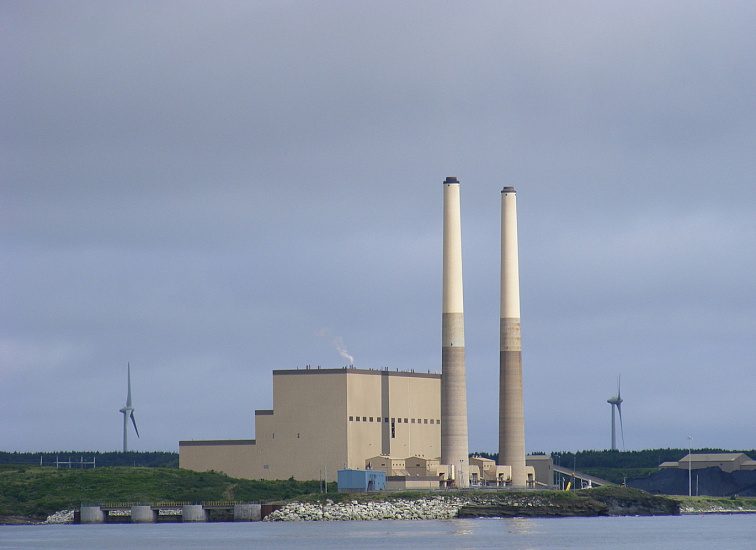
Note to readers: An earlier version of this piece was based on a misleading exhibit before the Utility and Review Board, indicating that sulphur dioxide emissions would be allowed to rise from about 60,000 to 90,000 tonnes in 2021 and 2022. A Nova Scotia Power spokesperson reports that the 90,000 figure was for two years – an average of 45,000 per year.
There was a blast from the past this week when Jennifer Henderson reported for the Halifax Examiner that the McNeil government is intending to let Nova Scotia Power increase its emissions of sulphur dioxide, aka SO2.
This news emerged as a byproduct of the main story about approval by the Utility and Review Board of a modest jump in electricity rates to cover increased fuel costs. Turns out the proposed increase – about 1.1 per cent a year over three years – would be greater but for the willingness of the Liberal government to degrade air quality with more SO2 from dirtier coal.
At present, NSP’s sulphur dioxide emissions are capped at 72,000 tonnes a year. NSP revealed to the utility board that the province intends to amend its Air Quality Regulations to allow 90,000 tonnes of emissions for 2021 and 2022.
“The revised SO2 emissions limit for 2020-2022 will result in significant savings in solid fuel costs for customers,” notes NSP.Translation: high sulphur coal is cheaper – and it appears NSP plans to burn a fair amount of it over the next two years.
According to NSP’s on-line air emissions reporting the utility belched out only 62,607 tonnes of sulphur dioxide in 2018 and never exceeded 67,000 tonnes in any year after 2010. Getting permission to go up to 90,000 tonnes – almost a 50 per cent increase over average levels for the last decade – suggests there is a lot of cheap high-sulphur coal in NSP’s immediate future.
On one hand, this is just another example of the McNeil government’s tendency to put stable power rates ahead of any effort to make our electricity system greener. But the seemingly casual willingness to allow a big jump in SO2 emissions also demonstrates how the politics of energy in this province have changed.
Acid Rain
More than 30 years ago, emissions of SO2, rather than greenhouse gasses, gripped the body politic. SO2 pumped into the air by coal-fired electrical utilities and heavy industry produces particulate matter. According to Ontario’s Environment Ministry exposure to high levels of this can lead to “breathing problems, respiratory illness, changes in the lung’s defences, and worsening respiratory and cardiovascular disease.”
(Given those health effects, perhaps there should be some public notice before the Nova Scotia government OKs a potential emissions increase of almost 50 per cent? But I digress.)
The Ontario Ministry’s air quality watchdog also notes that SO2, along with nitrogen oxides, “are the main precursors of acid rain. This contributes to the acidification of lakes and streams, accelerated corrosion of buildings and reduced visibility.”
It’s that last bit, the effect of acidification on lakes and streams, not the effect on people, that captured the attention of the public and Canadian politicians back in the 1980s. Since most of the acid rain affecting Canadian waters came from power utilities and heavy industry in the northeastern United States, Prime Minister Brian Mulroney mounted a crusade for an acid rain treaty with Washington.
After failing to convince the Reagan administration, the Mulroney government succeeded in getting a treaty agreement from George Bush the First, an achievement noted last year when Mulroney delivered the eulogy at Bush Sr.’s funeral.
The extent to which pressure from Canada was responsible for the US taking action is a matter for conjecture, but the reduction in sulphur dioxide emissions in the US has been spectacular. According to the US Environmental Protection Agency emissions have fallen from 15.73 million tons in 1990 to 1.26 million in 2018.
Reductions costly
In Nova Scotia, emissions reductions from Nova Scotia Power have been far less – the 62,607 emitted last year was only 60 per cent below 1989 levels. But that relatively modest drop was achieved at considerable expense in lives and treasure. Indeed, it can be argued that the coal-dependent box in which Nova Scotia finds itself today was reinforced by the politically-driven way the Conservative government of the day went about reducing sulphur dioxide pollution from NSP, source of 80 per cent of the province’s emissions.
This being Canada, part of Mulroney’s effort to achieve a treaty with the Americans involved getting the provinces on side. With an ease that’s incredible in comparison with today’s efforts to get provincial cooperation on climate change, Mulroney was able to cajole provinces into adopting the Eastern Canada Acid Rain Program. That meant a cap on the then government-owned Nova Scotia Power of 160,000 tonnes of SO2. That was actually about 14,000 tonnes more than the 146,000 tonnes emitted in 1989 by NSP, most of that coming from burning sulphurous Nova Scotia coal.
Although initially reluctant to accept such a cap, the Conservative government of John Buchanan eventually embraced the battle against acid rain, finding in it an opportunity to roll out a pork barrel of jobs and power plants.
As I wrote in Power Failure?, the government and NSP likely had a variety of possible ways to keep sulphur dioxide emissions below the cap – conservation, renewables, imports of low sulphur coal, or outfitting some units with scrubbers. Instead, they chose the counterintuitive and ultimately disastrous route of fighting fire with fire. Bizarrely, their antidote to SO2 pollution and acid rain caused by coal-fired power plants would become more coal mines and more power plants.
Westray and Pt. Aconi
The sudden concern about sulphur emissions gave new life to the coalfields of Pictou County. Although notoriously hazardous to mine, Pictou coal had an advantage over the Cape Breton coal then being used in NSP burners – it had less than half the sulphur content. Low sulphur coal to fulfill commitments under the Acid Rain Program became the main rationale for the development and massive subsidization of the ill-fated Westray mine. (The venture ended tragically in 1992 with an explosion that killed 26 men).
Government support for a Pictou mine that would potentially supply about a third of NSP’s coal requirements did not go down well in Cape Breton, where miners feared job losses would follow reductions in sales to NSP.
Not to worry. To ensure a stable market for high sulphur Cape Breton coal, the government/NSP brains trust came up with a novel plan. They would keep the coal fires burning with an expensive new plant at Point Aconi that would use avant-garde circulating fluidized-bed technology to remove about 90 per cent of the sulphur from Cape Breton’s dirtiest coal. Whether the additional power was actually needed was never clearly established.
When NSP’s token regulator, then known as the Public Utilities Board, retained an outside expert who said that importing low sulphur coal would be a much cheaper and simpler way to meet emission targets, the Conservatives, with support from the opposition, passed legislation removing the Point Aconi project from PUB scrutiny.
The Westray and Point Aconi developments, each justified as responding to the need to fight acid rain by reducing emissions of SO2, had major impact on future developments.
The blatant politicization revealed in both cases weakened support for public ownership, making it easier for the Conservatives to later pull off a misbegotten privatization of Nova Scotia Power. And over-building, which came to head with Point Aconi, set the stage for years of promoting electricity consumption, with accompanying greenhouse gas emissions, instead of pursuing conservation and efficiency measures.
Nova Scotia coal is mostly gone from NSP’s fuel mix, but we are still dealing with the consequences of futile actions to protect mining jobs, carried out in the guise of fighting acid rain. Considering how the long-ago campaign to lower SO2 had such impact on present circumstances it’s a bit mind-boggling that going in the other direction now seems to involve little more than a nudge and a wink between the government and the power company.
Richard Starr is a former journalist, civil servant, political hack and seventh generation Nova Scotian. He is devoting his retirement to family, volunteer activities and writing about subjects that interest him and, he hopes, others at Starr’s Point, a Nova Scotia blog where facts matter, where this post was originally published.His most recent book “Equal as Citizens: the tumultuous and troubled history of a great Canadian idea” is about the history of equalization and the fiscal transfer system in Canada and came out in 2014.
With a special thanks to our generous donors who make publication of the Nova Scotia Advocate possible.
Subscribe to the Nova Scotia Advocate weekly digest and never miss an article again. It’s free!



